|
Catherine Cartwright-Jones © 2004 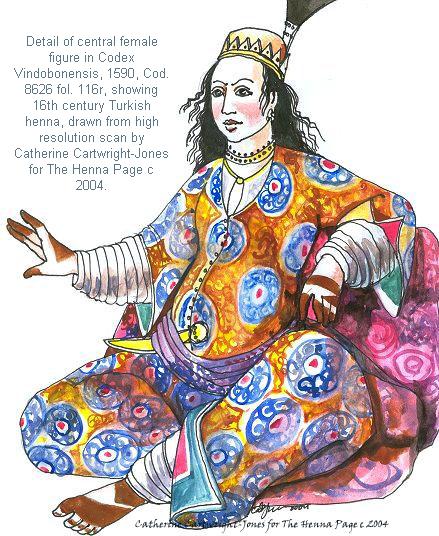 Detail drawn from Codex Vindobonensis, ca 1590, Cod. 8626 fol. 116r.* Catherine Cartwright-Jones © 2004 Codex
Vindobonensis,
ca 1590, Cod. 8626 fol. 116r, and other images in the same
collection show Ottoman Turkish women with a
unique henna style of bold asymmetrical wedges (detail above and
below). Bassamo da Zara, in I
Costumi et
I modi particolari de las vita de Turchi, also from the 16th
century,
says that Turkish women favored floral patterns. If both the
paintings
in the Codex and da Zara are to be taken as reliable sources, one may
interpret that these asymmetrical hennaed areas contained floral
patterning. Other representations of Ottoman and Turkoman henna
do show floral patterning, both incorporated into these shapes, and
other styles as well.
The images of five hennaed women in Cod. 8626 fol. 116r and other paintings of Turkish women in the Codex Vindobonensis show several levels of Ottoman Turkish style henna. The serving women and entertainers have henna on their fingertips up to the second knuckle of each finger, often done in a diagonal. The upper class women in Cod. 8626 fol. 116r (detail above and below) have bold, asymmetrical wedge patterns in henna. The henna patterns on these hands are very small, and do not have clear detail. miniature paintings of Turkish women is not visible either because of the limited scale, or because the European artist had limited access to Turkish women and was uncertain of the detail. Da Zara recorded that women hennaed their nails and hands, as well as their feet, sometimes shaping the henna like slippers, so this is consistant with the paintings of women in the Codex. 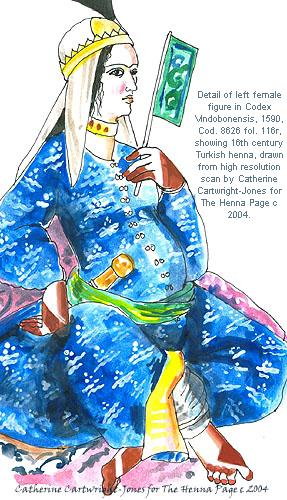 Drawn
from Codex Vindobonensis,
ca 1590, Cod. 8626 fol. 116r.*
Catherine Cartwright-Jones © 2004 Turkish depictions of Turkish women through this period are rare, but have more complete details of henna patterning than drawn by European artists such as the artist for Codex Vindobonensis. The scale was small, but the Turkish were more familiar with henna, and it was relatively important to them, so they made an effort to include detail. Painters tend to pay attention to what they feel is most significant. The Turkish Ravzat el Usak of Arifi from 1590 again show the angular asymmetrical style, though fine floral patterns are visible down the fingers. Retrieving henna patterning from depictions such as Ravzat el Usak of Arifi (below) is still difficult because of illustrations’ tiny scale. Manuscript paintings are rarely more than a few inches centimeters in any dimension. The hands and feet of the women are rarely more than .5 cm or ¼ inch long. The detail of henna patterning at that size is minimal, hampered by the spatial limitation. Despite these limitations, much information can be retrieved from high-resolution scans of the original works. 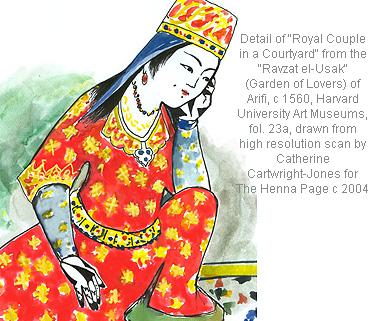 Detail from Royal Couple in a courtyard from the RAvzat el-Usak of Arifi, c 1560, Harvard University Art Museums, Fol. 23a* Catherine Cartwright-Jones © 2004 The Ravzat el-Usak (Garden of Lovers),
from 1560, shows exactly the same style of henna as is seen in the Codex
Vindobonensis, but is painted by a Turkish illustrated
manuscript artist, Arifi.
In Ravzat el-Usak, he shows a
princess gazing into a pool to see her reflection. Though the
dimensions of the hands are very small, the artist shows us more detail
in the hennaed hands than can be seen in the Codex. There are
delicate floral patterns diagonal across the fingertips, and there is a
hint of design within and around the wedge shapes.
The Turkoman manuscript depictions of henna in the last 1400s closely resemble not only the asymmetrical Ottoman henna, but have more complete details. More evidence of Ottoman style henna may be gathered from Turkoman manuscripts that were culturally related, and from which Turkish henna seems to have drawn its character. *The three illustrations above were created by tracing and hand painting high-resolution scans from the Codex Vindobonensis and Ravzat el-Usak to create the most accurate possible visualization of henna as was depicted. The hands and feet in the original art are very small. The position and general shape of the patterning is easy to verify and has been traced exactly. There seems to be patterning within these blocks of color, and it is certain from written description that Ottoman women of the 16th century had floral patterning. Other illustrations of Ottoman women have the same assymetrical, bold patterns, with more detail present. The details of henna patterns represented in these illuminations are not clearly visable, so I have not attempted to reconstruct the patterns in these images, though they may be inferred from other images, particularly from Turkoman images. Web resources on Ottoman Women http://www.allaboutturkey.com/woman.htm http://www.kismeta.com/diGrasse/Costume/ References: Akurgal, E. The Art and Architecture of Turkey Rizzoli, 1980 Atil, E. The Age of Sultan Suleyman the Magnificent Harry N. Abrams, Inc., New York Barber, N. "The Sultans" Simon and Schuster, New York, 1973 "Codex Vindobonensis" 1590 Croutier, Alev Lytle “Harem: The World Behind the Veil” Abbeville Press 1989 da Zara, Bassano “I Costumi et I modi particolari de las vita de Turchi” 1545 Penzer, N. M. "The Harem" Bookplan, 1936 Wheatcroft, A. The Ottomans Viking, 1993 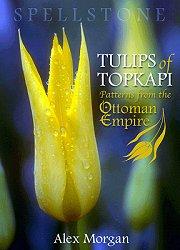
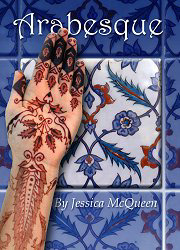 Alex Morgan's Tulips of Topkapi and Jessica McQueen's Arabesque have beautiful henna patterns adapted from Ottoman art! Available through TapDancing Lizard Can't find what you're looking for? Try: The Henna Page Main Index http://www.hennapage.com/henna/mainindex.html *"Henna,
the
Joyous Body Art"
the Encyclopedia of Henna Catherine Cartwright-Jones © 2000 registered with the US Library of Congress TXu 952-968 |